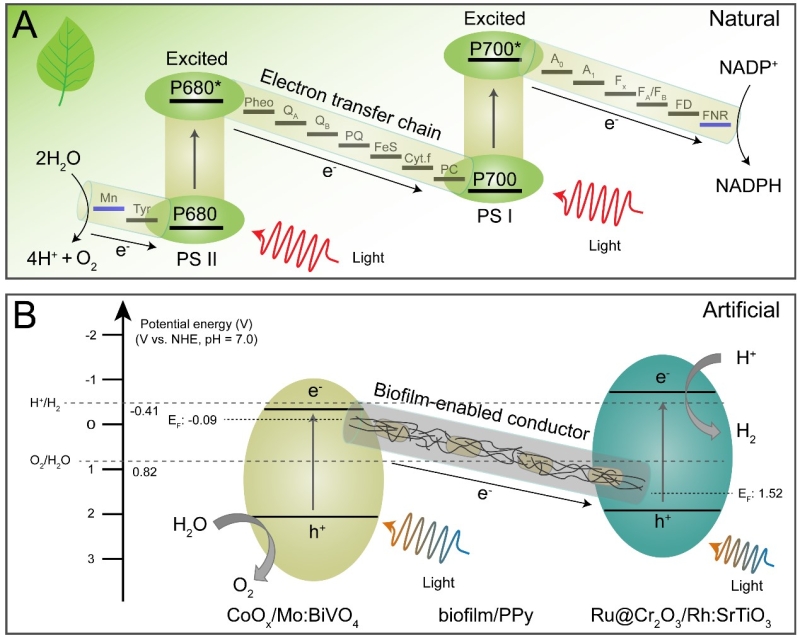Researchers Developed Novel Strategy for Sustainable Visible Light-Driven Overall Water Splitting
Date:27-06-2024 | 【Print】 【close】
A research team led by Prof. ZHONG Chao from the Shenzhen Institute of Advanced Technology (SIAT) of Chinese Academy of Sciences, in collaboration with Prof. MA Guijun from ShanghaiTech University has proposed a strategy for constructing conformal and conductive biofilms to enable stable, scalable, and sustainable visible light-driven overall water splitting.
The study was published in Science Advances on Jun.12.
Inspired by natural Z-scheme systems, researchers have developed various semi-artificial photosynthesis systems to capture and utilize solar energy. Typically, these systems, constructed by anchoring semiconductive nanoparticles on the surface of biological enzymes, facilitated light-driven reduction reactions, including hydrogen production, CO2 reduction, and N2 fixation. However, enzymes are susceptible to environmental exposure, highlighting the ongoing challenge of developing of efficient, stable, and sustainable semi-artificial Z-scheme systems.
Biofilms are entities of extracellular matrix with enwrapped bacterial cells. They possess numerous advantageous traits, including self-regeneration, self-adaption, resilience, and responsiveness to the surrounding environment. Due to the unique characteristics,
They possess numerous advantageous traits, including self-regeneration, self-adaption, resilience, and responsiveness to the surrounding environment. Due to the unique characteristics, biofilms could serve as a promising candidate for the development of semi-artificial Z-scheme systems.
biofilms could serve as a promising candidate for the development of semi-artificial Z-scheme systems.
In this study, researchers proposed a method that integrated conductive biofilms with high-efficiency photocatalysts. The resulting system consistently produced a 2:1 ratio of H2 and O2, indicating successful visible light-driven overall water splitting.
"Natural biofilms typically demonstrate low conductivity," the first author of this paper, Dr. WANG Xinyu said, "our study has engineered conductive biofilms specifically for Escherichia coli (E. coli) by utilizing an innovative in situ polymerization technique, thereby enhancing the biofilms ‘conductivity properties."
the first author of this paper, Dr. WANG Xinyu said, "our study has engineered conductive biofilms specifically for Escherichia coli (E. coli) by utilizing an innovative in situ polymerization technique, thereby enhancing the biofilms ‘conductivity properties."
Conductivity results demonstrated that the hybrid biofilms retained conductivity in both aqueous solution and under dry state. These results also indicated their potential applications in bioelectronic devices.
The researchers fabricated the hybrid Z-scheme sheet samples through a layer-by-layer method. A mixture of photocatalysts was drop-casted onto a glass plate, followed by the growth of biofilms and in situ polymerization process. They found that the resulting sheet exhibited the capability to function as a free-standing sheet while being resistant to sonication. The conductive biofilms enabled efficient charge separation, which subsequently facilitated visible light-driven overall water splitting. The vertical interparticle electron transfer relied on physical contact between particles, and thus, the inclusion of conductive substances within the photocatalyst layer further enhanced the efficiency of photocatalytic reactions.
Additionally, the researchers utilized light-assisted Kelvin probe force microscopy (AM-KPFM) to clarify the microscale process of electron transfer. Experimental results showed that the surface photovoltage difference was recorded as 69 mV, and the built-in electric field was determined to be 95 kV m-1, significantly exceeding values obtained from systems with only non-conductive E. coli biofilms. These findings indicate that the underlying conductive biofilms ensure a highly effective charge separation process, crucial for the exceptional photocatalytic performance observed.
This work not only advances the frontier of engineered living energy materials but also holds promise for other bio-integrated systems and devices.

Schematics of natural (A) and artificial (B) Z-scheme systems. (Image by SIAT)
Media Contact:
ZHANG Xiaomin
Email:xm.zhang@siat.ac.cn